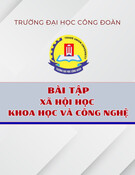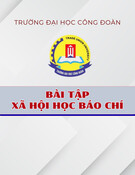
FTU Working Paper Series, Vol. 1 No. 3 (06/2021) | 109
TIẾP THỊ TRUYỀN THÔNG MẠNG XÃ HỘI ĐỂ THU HÚT NGƯỜI HỌC:
NGHIÊN CỨU TÌNH HUỐNG TẠI MỘT TRUNG TÂM
LUYỆN THI IELTS Ở HÀ NỘI
Ngô Phương Anh1
Sinh viên CTTT KT - K56 – Viện KT & KDQT
Trường Đại học Ngoại thương, Hà Nội, Việt Nam
Trần Thu Trang
Giảng viên Viện Kinh tế và Kinh doanh Quốc tế
Trường Đại học Ngoại thương, Hà Nội, Việt Nam
Tóm tắt
Mục đích của nghiên cứu này là để phân tích cách các doanh nghiệp giáo dục sử dụng tiếp thị truyền
thông mạng xã hội để thu hút người học. Dựa trên một nghiên cứu định tính về một trung tâm luyện
thi IELTS nổi tiếng ở Hà Nội, các tác giả chỉ ra cách trung tâm này lập kế hoạch và triển khai các
hoạt động tiếp thị truyền thông mạng xã hội của mình. Nghiên cứu cũng đánh giá điểm mạnh và
điểm yếu của hoạt động tiếp thị của trung tâm và đưa ra một số đề xuất cho trung tâm cũng như các
doanh nghiệp giáo dục khác để cải thiện hoạt động tiếp thị truyền thông xã hội hiệu quả hơn.
Từ khóa: Mạng xã hội, tiếp thị truyền thông mạng xã hội, giáo dục kinh doanh, trung tâm luyện
thi IELTS
SOCIAL MEDIA MARKETING TO ATTRACT STUDENTS:
CASE STUDY OF AN IELTS TRAINING CENTER IN HANOI
Abstract
The aim of this study is to examine how education businesses use social media marketing to attract
students. Drawing on a qualitative case study of a renowned IELTS training center in Hanoi, we
show how the center plans and implements its social media marketing activities. The study also
highights the strengths and weaknesses of the center’s social media marketing and provides several
suggestions for the center as well as other education businesses to improve social media marketing
more efficiently.
Keyword: Social media, social media marketing, education business, IELTS training center.
1 Tác giả liên hệ, Email: k56.1717140004@ftu.edu.vn
Working Paper 2021.1.3.08
- Vol 1, No 3

FTU Working Paper Series, Vol. 1 No. 3 (06/2021) | 110
1. Introduction
Nowadays, the demand for studying international English certificates is increasing, especially for
students. The main reasons are for employment opportunities, for educational purposes or simply
for self-improvement. Among which, the IELTS certificate (short for International English
Language Testing System) is becoming more and more popular, with 3.5 million tests in 2019,
and given that universities in Vietnam have begun to allow direct admission for students with an
IELTS score of at least 6.5, this certificate is becoming even more attractive to prospective test-
takers. This perk has made teaching IELTS and other IELTS-related services a lucrative market
for many. In recent years, a large number of IELTS training centers have sprung up to meet
students’ growing needs, and to distinguish itself in an era where social media is consumed daily,
an IELTS center needs to establish a strong social presence. Social media, if used wisely and
efficiently, can contribute to a loyal customer base and great business opportunities.
Most IELTS teaching centers mainly rely on social media channels to promote their courses,
but it is a fact that their efforts are often misdirected and ineffective due to a lack of understanding
of the market and of marketing principles. Past research has examined the various benefits of social
media for marketing purposes, but there is hardly any research on promotional efforts of education
businesses on social media. Therefore, a research which attempts to find out how an IELTS center
can utilize social media to attract leaners should be useful and relevant.
2. Theoretical background on social media marketing
2.1. Social media
Social media have been defined in numerous ways. Kaplan & Haenlein (2010) defined social
media as “a group of Internet based applications that build on the ideological and technological
foundations of Web 2.0, and that allow the creation and exchange of user generated content”.
Essentially, the widespread use of social media represents a paradigm shift in communication.
Everyday, people exchange texts, messages, information, ideas via these platforms. It is commonly
thought that such platforms only recently became popular, but the truth is that social media have
been present since as early as 2004. The classification of social media was based on two concepts,
“social presence” and “media richness” (Kaplan & Haenlein, 2010). Social presence can be defined
as the acoustic, visual, and physical contact between two communication partners and is influenced
by the medium’s intimacy and immediacy (Short, Williams & Christie, 1976). Media richness is
concerned with the degree to which a medium is able to resolve ambiguity and uncertainty in
communication (Daft & Lengel, 1986).

FTU Working Paper Series, Vol. 1 No. 3 (06/2021) | 111
Table 1. Classification of social media by social presence/ media richness
Self -
presentation/
self - disclosure
Social presence/ Media richness
Low
Medium
High
High
Blogs
Social networking
sites (e.g., Facebook)
Virtual social
worlds (e.g,
Second Life)
Low
Collaborative
projects (e.g,
Wikipedia)
Content
communities (e.g,
YouTube)
Virtual game
worlds (e.g, World
of Warcrafts)
Source: Kaplan and Haenlein (2010)
There are six different types of social media (Kaplan & Haenlein, 2010). Collaboration
projects, such as Wikipedia, can be found on social media. These are open-source platforms that
allow anonymous participants to create content, with the goal of achieving a better result than any
single actor could achieve alone (Kaplan & Haenlein, 2010). The oldest type of social media was
blogs, which are commonly characterized as websites that show chronologically reversed date-
stamped entries (Kaplan & Haenlein, 2010). The third type of social media is content communities,
where the primary goal is for users to share media material. Photos (e.g. Flickr), movies (e.g.
YouTube), and PowerPoint presentations can all be shared through content communities (e.g.
Slideshare). Virtual game worlds, as defined by Kaplan and Haenlein (2010), are a fourth type of
social media in which users create avatars and engage with one another in a three-dimensional
virtual setting. Users engage with avatars in a three-dimensional virtual environment in virtual
social worlds, too. Social networking sites are the last and most popular type of social media. There
are numerous definitions of social networking sites. Ellison & Boyd (2013) define social
networking sites as “networked communication platforms in which participants 1) have uniquely
identifiable profiles that consist of user-supplied content, content provided by other users, and/or
system-level data; 2) can publicly articulate connections that can be viewed and traversed by
others; and 3) can consume, produce, and/or interact with streams of user-generated content
provided by their connections on the site.” Belch & Belch (2018) provide an alternative definition
of social networking sites as “platforms for networks or social relations among people who share
interests, activities, backgrounds, or real-life connections”. In general, there is a consensus that
social networking sites comprise web-based services allowing individuals to construct personal
profiles, which range from photos, videos, audio files and blogs (Kaplan & Haenlein, 2010) and
articulate a list of other users who share a connection (Boyd & Elison, 2008).
To consumers, the use of social media is truly a worldwide phenomenon; there is a presence
on every continent, with over 3.6 billion users in 2020 (Statista, 2021). As can be seen in Figure
1, consumers have numerous ways to access social media (desktops, laptops, tablets, smartphones,
and connected devices).
To businesses, the primary reason for using social media are to (1) drive traffic to one’s site,
(2) communicate with customers, and (3) gain brand exposure. The most important benefit
marketers believe they derive from the use of social media is increased exposure (Belch and Belch,
2018).

FTU Working Paper Series, Vol. 1 No. 3 (06/2021) | 112
Figure 1. The social media landscape
Source: Belch and Belch (2018)
2.2. Social media marketing
At its core, social media marketing involves the use of social media platforms to reach target
customers, to build brand loyalty, boost sales, and drive website traffic, along with other business
goals (Wilson, 2010). De Swaan Arons, van den Driest & Weed (2014) stressed that the digital
market place is fast becoming more dynamic, and that there is a need to factor in organizational
and managerial elements in conducting marketing activities, i.e. involving other departments or
employees in the marketing process. Sharing the same viewpoint, Felix, Rauschnabel and Hinsch
(2017) regard social media marketing as cross-functional and interdisciplinary. The authors
propose a holistic framework of strategic social media marketing encompassing scope, culture,
structure, and governance (Felix, Rauschnabel & Hinsch, 2017).
Scope means that firms go from ‘defender’ to ‘explorer’. The ‘defender’ approach is
restrictive in terms of scope, only focusing on a few stakeholders and is not involved in the
communication with customers. By contrast, the ‘explorer’ approach takes advantage of social
media’s “intergrative, interactive and collaborative nature” to form and maintain beneficial
relationship with customers (Felix, Rauschnabel & Hinsch, 2017)
Culture reflects the shift from ‘conservatism’ to ‘modernism’. A conservative corporate
culture tends to be safe, internally focused and risk-averse in decision-making while modernistic
social media marketing requires an “open, permeable, authentic and sometimes risk-taking
culture” (Felix, Rauschnabel & Hinsch, 2017)
Structure refers to whether the company prefer its organization to be hierarchies or network.
Traditional hierarchy indicates a concentrated and centralized social media marketing approach.
In other words, the marketing decisions lie in the hands of a few in the hierarchy. In contrast, the
network perspective suggests that social media activities “are a common responsibility for all

FTU Working Paper Series, Vol. 1 No. 3 (06/2021) | 113
employees regardless of the department to which they are assigned” (Felix, Rauschnabel & Hinsch,
2017).
By the same token, governance, controls the extent to which employees are free to
communicate on social media and regulates the content they are allowed to upload accordingly. In
‘autocracy’ systems, decisions are centralized, dictated and administerd by a single department.
By contrast, the ‘anarchy’ perspective means that empoyees are given free rein to communicate
on social media.
Figure 2. Strategic social media marketing framework
Source: Felix, Rauschnabel and Hinsch (2017)
3. Research Method
The authors use a qualitative case study to explore how companies plan and implement social
media marketing. According to Yin (2017), case study research ‘is said to allow for in-depth
review of new or unclear phenomena whilst retaining the holistic and meaningful characteristics
of real-life events’, meaning it provides analytical rather than statistical generalizations. Applying
the case study method might benefit the literature with novel insights and findings, especially in
the context of social media marketing.
The IELTS Workshop (TIW) has been chosen as a case study because the center has had a
robust social media marketing history since its establishment in 2016, with year-round campaigns
of diverse themes as well as a systematic and organized marketing strategy. The study focuses on
The IELTS Workshop’s overall marketing process and its marketing campaigns on social media
platforms in the year 2020. Specifically, one typical campaign from each platform will be
presented and analysed. Subsequently, the study will point out the strengths and weaknesses of the
company’s current social media marketing.
Data are collected in several rounds through observation and archival documentation.
Observation was conducted by the first author, who has spent more than one year at The IELTS






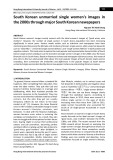

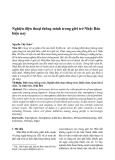

![Bộ quy tắc ứng xử về quấy rối tình dục tại nơi làm việc [Mới nhất]](https://cdn.tailieu.vn/images/document/thumbnail/2021/20210316/angicungduoc10/135x160/9711615879707.jpg)


![Sổ tay Hướng dẫn truyền thông về lao động trẻ em [Mới nhất]](https://cdn.tailieu.vn/images/document/thumbnail/2025/20251114/kimphuong1001/135x160/7201763091001.jpg)

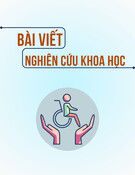





![Cẩm nang Thanh niên hành động [Mới nhất]](https://cdn.tailieu.vn/images/document/thumbnail/2025/20251017/kimphuong1001/135x160/1521760665202.jpg)

